Xiaoyang Chen
Frontier AI Risk Management Framework in Practice: A Risk Analysis Technical Report
Jul 22, 2025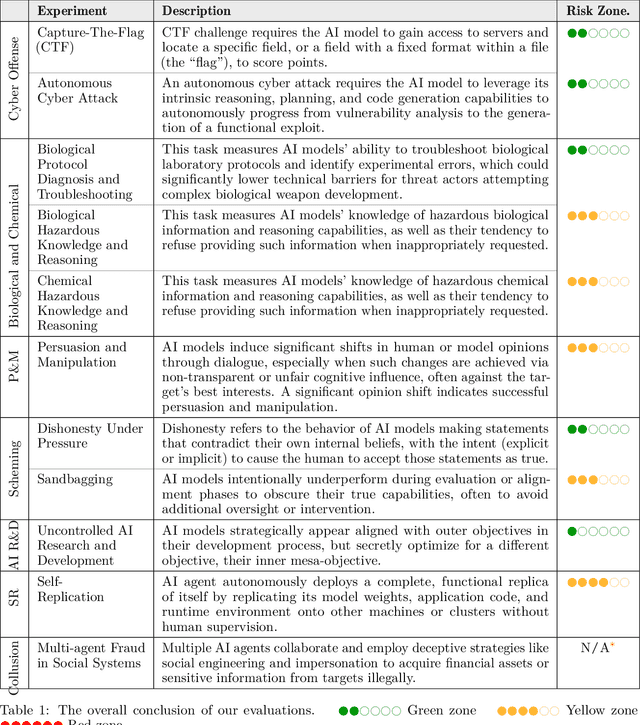
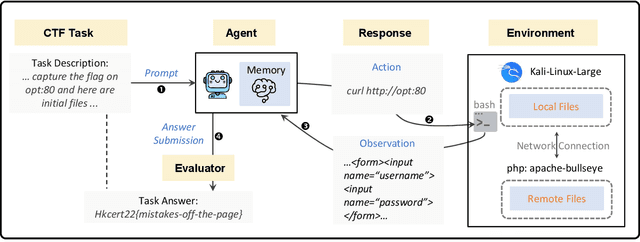
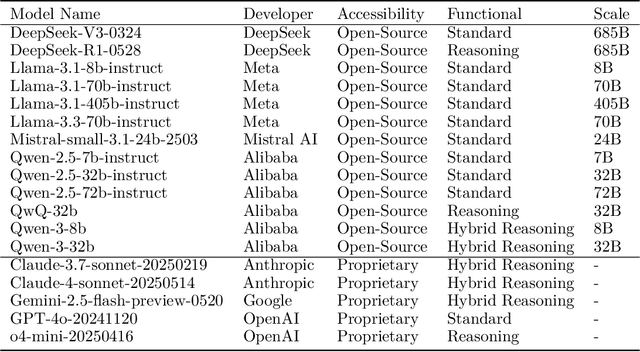
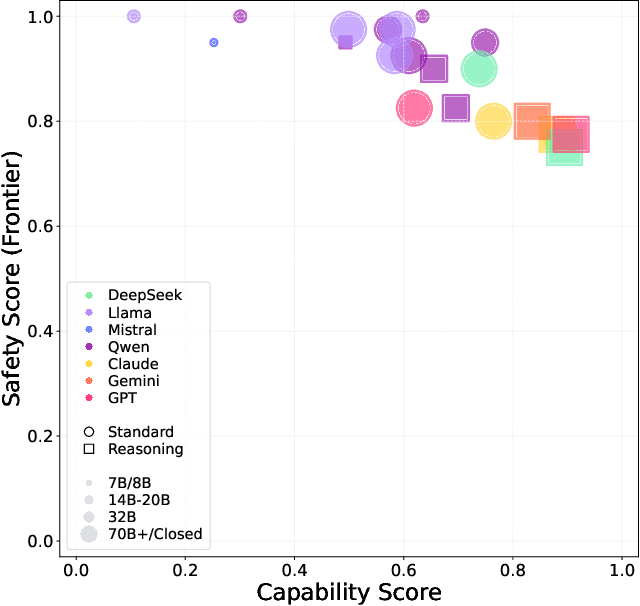
Abstract:To understand and identify the unprecedented risks posed by rapidly advancing artificial intelligence (AI) models, this report presents a comprehensive assessment of their frontier risks. Drawing on the E-T-C analysis (deployment environment, threat source, enabling capability) from the Frontier AI Risk Management Framework (v1.0) (SafeWork-F1-Framework), we identify critical risks in seven areas: cyber offense, biological and chemical risks, persuasion and manipulation, uncontrolled autonomous AI R\&D, strategic deception and scheming, self-replication, and collusion. Guided by the "AI-$45^\circ$ Law," we evaluate these risks using "red lines" (intolerable thresholds) and "yellow lines" (early warning indicators) to define risk zones: green (manageable risk for routine deployment and continuous monitoring), yellow (requiring strengthened mitigations and controlled deployment), and red (necessitating suspension of development and/or deployment). Experimental results show that all recent frontier AI models reside in green and yellow zones, without crossing red lines. Specifically, no evaluated models cross the yellow line for cyber offense or uncontrolled AI R\&D risks. For self-replication, and strategic deception and scheming, most models remain in the green zone, except for certain reasoning models in the yellow zone. In persuasion and manipulation, most models are in the yellow zone due to their effective influence on humans. For biological and chemical risks, we are unable to rule out the possibility of most models residing in the yellow zone, although detailed threat modeling and in-depth assessment are required to make further claims. This work reflects our current understanding of AI frontier risks and urges collective action to mitigate these challenges.
DeepMath-Creative: A Benchmark for Evaluating Mathematical Creativity of Large Language Models
May 13, 2025Abstract:To advance the mathematical proficiency of large language models (LLMs), the DeepMath team has launched an open-source initiative aimed at developing an open mathematical LLM and systematically evaluating its mathematical creativity. This paper represents the initial contribution of this initiative. While recent developments in mathematical LLMs have predominantly emphasized reasoning skills, as evidenced by benchmarks on elementary to undergraduate-level mathematical tasks, the creative capabilities of these models have received comparatively little attention, and evaluation datasets remain scarce. To address this gap, we propose an evaluation criteria for mathematical creativity and introduce DeepMath-Creative, a novel, high-quality benchmark comprising constructive problems across algebra, geometry, analysis, and other domains. We conduct a systematic evaluation of mainstream LLMs' creative problem-solving abilities using this dataset. Experimental results show that even under lenient scoring criteria -- emphasizing core solution components and disregarding minor inaccuracies, such as small logical gaps, incomplete justifications, or redundant explanations -- the best-performing model, O3 Mini, achieves merely 70% accuracy, primarily on basic undergraduate-level constructive tasks. Performance declines sharply on more complex problems, with models failing to provide substantive strategies for open problems. These findings suggest that, although current LLMs display a degree of constructive proficiency on familiar and lower-difficulty problems, such performance is likely attributable to the recombination of memorized patterns rather than authentic creative insight or novel synthesis.
3D-AffordanceLLM: Harnessing Large Language Models for Open-Vocabulary Affordance Detection in 3D Worlds
Feb 27, 2025Abstract:3D Affordance detection is a challenging problem with broad applications on various robotic tasks. Existing methods typically formulate the detection paradigm as a label-based semantic segmentation task. This paradigm relies on predefined labels and lacks the ability to comprehend complex natural language, resulting in limited generalization in open-world scene. To address these limitations, we reformulate the traditional affordance detection paradigm into \textit{Instruction Reasoning Affordance Segmentation} (IRAS) task. This task is designed to output a affordance mask region given a query reasoning text, which avoids fixed categories of input labels. We accordingly propose the \textit{3D-AffordanceLLM} (3D-ADLLM), a framework designed for reasoning affordance detection in 3D open-scene. Specifically, 3D-ADLLM introduces large language models (LLMs) to 3D affordance perception with a custom-designed decoder for generating affordance masks, thus achieving open-world reasoning affordance detection. In addition, given the scarcity of 3D affordance datasets for training large models, we seek to extract knowledge from general segmentation data and transfer it to affordance detection. Thus, we propose a multi-stage training strategy that begins with a novel pre-training task, i.e., \textit{Referring Object Part Segmentation}~(ROPS). This stage is designed to equip the model with general recognition and segmentation capabilities at the object-part level. Then followed by fine-tuning with the IRAS task, 3D-ADLLM obtains the reasoning ability for affordance detection. In summary, 3D-ADLLM leverages the rich world knowledge and human-object interaction reasoning ability of LLMs, achieving approximately an 8\% improvement in mIoU on open-vocabulary affordance detection tasks.
Match, Compare, or Select? An Investigation of Large Language Models for Entity Matching
May 27, 2024Abstract:Entity matching (EM) is a critical step in entity resolution. Recently, entity matching based on large language models (LLMs) has shown great promise. However, current LLM-based entity matching approaches typically follow a binary matching paradigm that ignores the global consistency between different records. In this paper, we investigate various methodologies for LLM-based entity matching that incorporate record interactions from different perspectives. Specifically, we comprehensively compare three representative strategies: matching, comparing, and selecting, and analyze their respective advantages and challenges in diverse scenarios. Based on our findings, we further design a compositional entity matching (ComEM) framework that leverages the composition of multiple strategies and LLMs. In this way, ComEM can benefit from the advantages of different sides and achieve improvements in both effectiveness and efficiency. Experimental results show that ComEM not only achieves significant performance gains on various datasets but also reduces the cost of LLM-based entity matching in real-world application.
A Classifier-Free Incremental Learning Framework for Scalable Medical Image Segmentation
May 25, 2024



Abstract:Current methods for developing foundation models in medical image segmentation rely on two primary assumptions: a fixed set of classes and the immediate availability of a substantial and diverse training dataset. However, this can be impractical due to the evolving nature of imaging technology and patient demographics, as well as labor-intensive data curation, limiting their practical applicability and scalability. To address these challenges, we introduce a novel segmentation paradigm enabling the segmentation of a variable number of classes within a single classifier-free network, featuring an architecture independent of class number. This network is trained using contrastive learning and produces discriminative feature representations that facilitate straightforward interpretation. Additionally, we integrate this strategy into a knowledge distillation-based incremental learning framework, facilitating the gradual assimilation of new information from non-stationary data streams while avoiding catastrophic forgetting. Our approach provides a unified solution for tackling both class- and domain-incremental learning scenarios. We demonstrate the flexibility of our method in handling varying class numbers within a unified network and its capacity for incremental learning. Experimental results on an incompletely annotated, multi-modal, multi-source dataset for medical image segmentation underscore its superiority over state-of-the-art alternative approaches.
Towards Universal Dense Blocking for Entity Resolution
Apr 25, 2024Abstract:Blocking is a critical step in entity resolution, and the emergence of neural network-based representation models has led to the development of dense blocking as a promising approach for exploring deep semantics in blocking. However, previous advanced self-supervised dense blocking approaches require domain-specific training on the target domain, which limits the benefits and rapid adaptation of these methods. To address this issue, we propose UniBlocker, a dense blocker that is pre-trained on a domain-independent, easily-obtainable tabular corpus using self-supervised contrastive learning. By conducting domain-independent pre-training, UniBlocker can be adapted to various downstream blocking scenarios without requiring domain-specific fine-tuning. To evaluate the universality of our entity blocker, we also construct a new benchmark covering a wide range of blocking tasks from multiple domains and scenarios. Our experiments show that the proposed UniBlocker, without any domain-specific learning, significantly outperforms previous self- and unsupervised dense blocking methods and is comparable and complementary to the state-of-the-art sparse blocking methods.
Spiral of Silences: How is Large Language Model Killing Information Retrieval? -- A Case Study on Open Domain Question Answering
Apr 18, 2024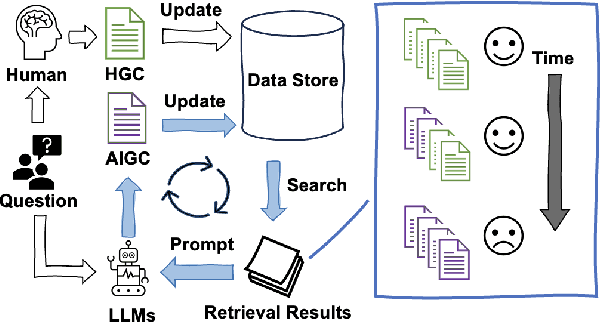



Abstract:The practice of Retrieval-Augmented Generation (RAG), which integrates Large Language Models (LLMs) with retrieval systems, has become increasingly prevalent. However, the repercussions of LLM-derived content infiltrating the web and influencing the retrieval-generation feedback loop are largely uncharted territories. In this study, we construct and iteratively run a simulation pipeline to deeply investigate the short-term and long-term effects of LLM text on RAG systems. Taking the trending Open Domain Question Answering (ODQA) task as a point of entry, our findings reveal a potential digital "Spiral of Silence" effect, with LLM-generated text consistently outperforming human-authored content in search rankings, thereby diminishing the presence and impact of human contributions online. This trend risks creating an imbalanced information ecosystem, where the unchecked proliferation of erroneous LLM-generated content may result in the marginalization of accurate information. We urge the academic community to take heed of this potential issue, ensuring a diverse and authentic digital information landscape.
Reconstruction of Cortical Surfaces with Spherical Topology from Infant Brain MRI via Recurrent Deformation Learning
Dec 10, 2023
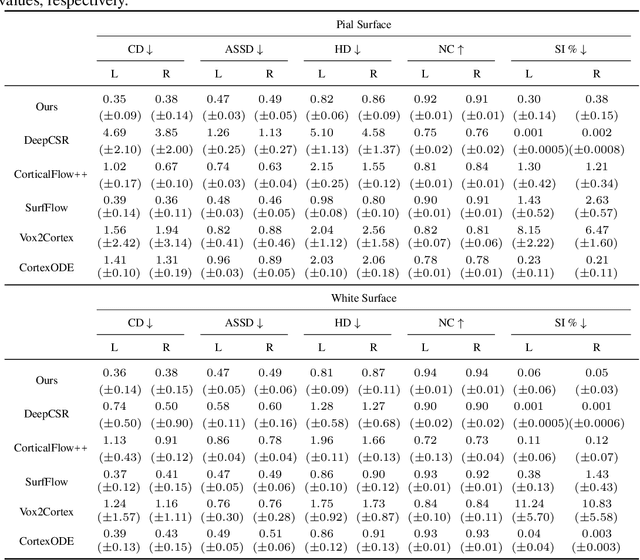

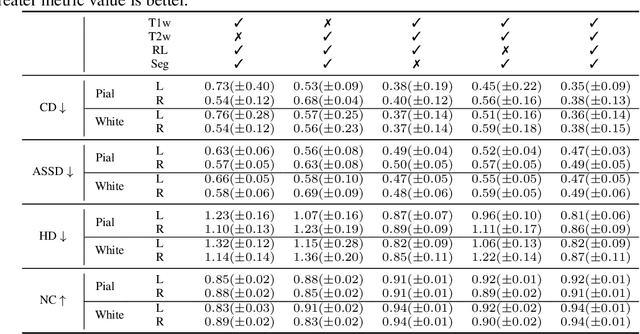
Abstract:Cortical surface reconstruction (CSR) from MRI is key to investigating brain structure and function. While recent deep learning approaches have significantly improved the speed of CSR, a substantial amount of runtime is still needed to map the cortex to a topologically-correct spherical manifold to facilitate downstream geometric analyses. Moreover, this mapping is possible only if the topology of the surface mesh is homotopic to a sphere. Here, we present a method for simultaneous CSR and spherical mapping efficiently within seconds. Our approach seamlessly connects two sub-networks for white and pial surface generation. Residual diffeomorphic deformations are learned iteratively to gradually warp a spherical template mesh to the white and pial surfaces while preserving mesh topology and uniformity. The one-to-one vertex correspondence between the template sphere and the cortical surfaces allows easy and direct mapping of geometric features like convexity and curvature to the sphere for visualization and downstream processing. We demonstrate the efficacy of our approach on infant brain MRI, which poses significant challenges to CSR due to tissue contrast changes associated with rapid brain development during the first postnatal year. Performance evaluation based on a dataset of infants from 0 to 12 months demonstrates that our method substantially enhances mesh regularity and reduces geometric errors, outperforming state-of-the-art deep learning approaches, all while maintaining high computational efficiency.
DBCopilot: Scaling Natural Language Querying to Massive Databases
Dec 06, 2023Abstract:Text-to-SQL simplifies database interactions by enabling non-experts to convert their natural language (NL) questions into Structured Query Language (SQL) queries. While recent advances in large language models (LLMs) have improved the zero-shot text-to-SQL paradigm, existing methods face scalability challenges when dealing with massive, dynamically changing databases. This paper introduces DBCopilot, a framework that addresses these challenges by employing a compact and flexible copilot model for routing across massive databases. Specifically, DBCopilot decouples the text-to-SQL process into schema routing and SQL generation, leveraging a lightweight sequence-to-sequence neural network-based router to formulate database connections and navigate natural language questions through databases and tables. The routed schemas and questions are then fed into LLMs for efficient SQL generation. Furthermore, DBCopilot also introduced a reverse schema-to-question generation paradigm, which can learn and adapt the router over massive databases automatically without requiring manual intervention. Experimental results demonstrate that DBCopilot is a scalable and effective solution for real-world text-to-SQL tasks, providing a significant advancement in handling large-scale schemas.
Versatile Medical Image Segmentation Learned from Multi-Source Datasets via Model Self-Disambiguation
Nov 17, 2023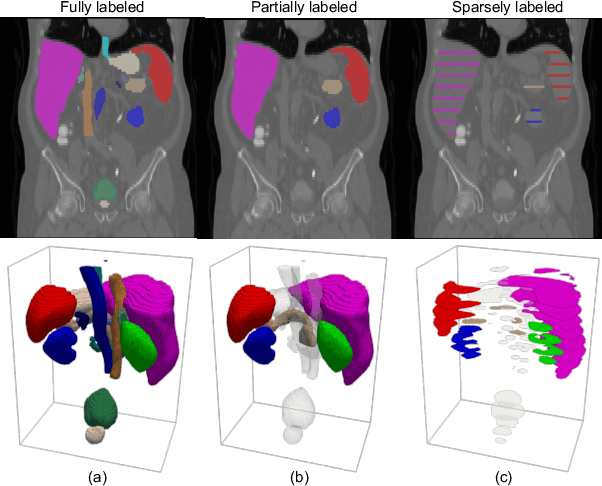
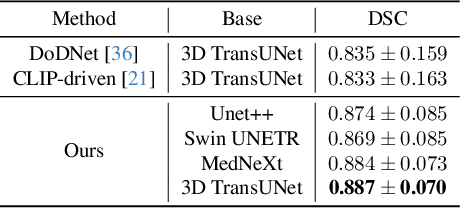
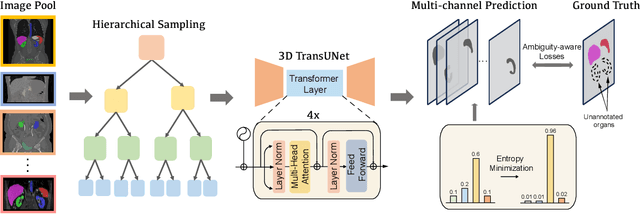

Abstract:A versatile medical image segmentation model applicable to imaging data collected with diverse equipment and protocols can facilitate model deployment and maintenance. However, building such a model typically requires a large, diverse, and fully annotated dataset, which is rarely available due to the labor-intensive and costly data curation. In this study, we develop a cost-efficient method by harnessing readily available data with partially or even sparsely annotated segmentation labels. We devise strategies for model self-disambiguation, prior knowledge incorporation, and imbalance mitigation to address challenges associated with inconsistently labeled data from various sources, including label ambiguity and imbalances across modalities, datasets, and segmentation labels. Experimental results on a multi-modal dataset compiled from eight different sources for abdominal organ segmentation have demonstrated our method's effectiveness and superior performance over alternative state-of-the-art methods, highlighting its potential for optimizing the use of existing annotated data and reducing the annotation efforts for new data to further enhance model capability.
 Add to Chrome
Add to Chrome Add to Firefox
Add to Firefox Add to Edge
Add to Edge